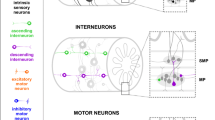Abstract
This study examines neurotransmission between identified buccal interneurons in the feeding system of the snailLymnaea stagnalis. We compare the pharmacology of the individual synaptic connections from a hybrid modulatory/pattern generating interneuron (N1L) to a pattern generating interneuron (N1M) with that from a modulatory interneuron (SO) to the same follower cell (N1M).
The pharmacological properties of the N1L to N1M and the SO to N1M connections closely resemble each other. Both interneurons produce fast cholinergic EPSPs as judged by the blocking effects of cholinergic antagonists hexamethonium,d-tubocurarine and the cholinergic neurotoxin AF-64A. A slower, more complex but non-cholinergic component of the synaptic response is also present after stimulating either the presynaptic N1L or SO interneurons. This second component of the postsynaptic response is not dopaminergic, on the basis of its persistence in the presence of dopaminergic antagonists ergometrine and fluphenazine and the dopaminergic neurotoxin MPP+.
We conclude that, although there has been an evolutionary divergence in function, the modulatory SO and the hybrid modulatory/pattern generating N1L are pharmacologically similar. Neither of them contributes directly to dopaminergic modulation of the feeding activity. These neurons also resemble the N1M protraction phase pattern generating neurons which are cholinergic (Elliott and Kemenes, 1992).
Similar content being viewed by others
References
Elekes, K., Kemenes, G., Hiripi, L., Geffard, M. and Benjamin, P. R. (1991) Dopamine-immunoreactive neurones in the central nervous system of the pond snailLymnaea stagnalis.J. Comp. Neurol.,307, 214–224.
Elliott, C. J. H. and Benjamin, P. R. (1985a) Interactions of pattern-generating interneurons controlling feeding inLymnaea stagnalis.J. Neurophysiol.,54, 1396–1411.
Elliott, C. J. H. and Benjamin, P. R. (1985b) Interactions of the slow oscillator interneuron with feeding pattern generating interneurons inLymnaea stagnalis.J. Neurophysiol.,54, 1412–1421.
Elliott, C. J. H., Stow, R. A. and Hastwell, C. (1992) Cholinergic interneurons in the feeding system of the pond snailLymnaea stagnalis. I. Cholinergic receptors on feeding neurons.Phil. Trans. R. Soc. Land. B,336, 157–166.
Elliott, C. J. H. and Kemenes, G. (1992) Cholinergic interneurons in the feeding system of the pond snailLymnaea stagnalis. II. N1 interneurons make cholinergic synapses with feeding motoneurons.Phil. Trans. R. Soc. Lond. B,336, 167–180.
Kemenes, G. and Elliott, C. J. H. (1994) Analysis of the feeding motor pattern in the pond snail,Lymnaea stagnalis: photoinactivation of axonally stained pattern generating interneurons.J. Neurosci.,14, 153–166.
Kyriakides, M. A. and McCrohan, C. R. (1989) Effect of putative neuromodulators on rhythmic buccal motor output inLymnaea stagnalis.J. Neurobiol.,20, 635–650.
Lloyd, P. E. Frankfurt, M., Stevens, P., Kupfermann, I. and Weiss, K. R. (1987) Biochemical and immunocytological localization of the neuropeptides FMRFamide, SCPA and SCPB to neurons involved in feeding inAplysia.J. Neurosci.,7, 1123–1132.
Miller, M. W., Alevizos, A., Cropper, E. C., Vilim, F. S., Karagogeos, D., Kupfermann, I. and Weiss, K. R. (1991) Localization of myomodulin-like immunoreactivity in the central nervous system and peripheral tissues ofAplysia californica.J. Comp. Neurol.,314, 627–644.
Miller, M. W., Alevizos, A., Cropper, E. C., Kupfermann, I. and Weiss, K. R. (1992) Distribution of buccalin-like imunoreactivity in the central nervous system and peripheral tissues ofAplysia californica.J. Comp. Neurol.,320, 182–195.
Rose, R. M., and Benjamin P. R. (1981) Interneuronal control of feeding in the pond snailLymnaea stagnalis. I. Initiation of feeding cycles by a single buccal interneurone.J. Exp. Biol.,92, 187–201.
Santama, N., Brierley, M., Burke, J. F. and Benjamin, P. R. (1994) Neural network controlling feeding inLymnaea stagnalis: immunocytochemical localization of myomodulin, small cardioactive peptide, buccalin and FMRFamide-related peptides.J. Comp. Neurol.,342, 352–365.
Sandberg, K. Schnaar, R. L., McKinney, M., Hanin, I., Fisher, A. and Coyle, J. T. (1985) AF64A: an active site directed irreversible inhibitor of choline acetyltransferase.J. Neurochem.,44, 439–445.
Sossin, W., Kirk, M. D. and Sheller, R. H. (1987) Peptidergic modulation of neural circuitry controlling feeding inAplysia.J. Neurosci.,7, 671–681.
Taussig, R., Sweet-Cordero, A. and Sheller, R. H. (1989) Modulation of ionic currents inAplysia motor neuron B15 by serotonin, neuropeptides, and second messengers.J. Neurosci.,9, 32183–229.
Teyke, T., Rosen, S.C., Weiss, K.R. and Kupfermann, I. (1993) Dopaminergic neuron B20 generates rhythmic neuronal activity in the feeding motor circuitry ofAplysia.Brain Res.,630, 226–237.
Trimble, D. L. and Barker, D. L. (1984) Activation by dopamine of patterned motor output from the buccal ganglia ofHelisoma trivolvis.J. Neurobiol.,15, 37–48.
Walker, R. J. (1986) Transmitters & modulators. InThe Mollusca 9B ed. A. O. D. Willows, pp. 279–485. Orlando: Academic Press.
Weiss, K. R., Brezina, V., Cropper, E. C., Hooper, S. L., Miller, M.W., Probst, W. C., Vlim, F. S. and Kupfermann, I. (1992) Peptidergic cotransmission inAplysia: functional implications of rhythmic behaviors.Experientia,48, 456–463.
Whim, M. D. and Lloyd, P. E. (1990) Neuropeptide cotransmitters released from an identified cholinergic motor neuron modulate neuromuscular efficacy inAplysia.J. Neurosci.,10, 3313–3322.
Wieland, S. J. and Gelperin, A. (1983) Dopamine elicits feeding motor program inLimax maximus.J. Neurosci.,3, 1735–1745.
Yeoman, M. S., Parish, D. C. and Benjamin, P. R. (1993) A cholinergic modulatory interneuron in the feeding system of the snailLymnaea.J. Neurophysiol.,70, 37–50.
Yeoman, M. S., Vehovszky, A., Kemenes, G., Elliott, C. J. H. and Benjamin, P. R. (1995) A novel interneuron having hybrid modulatory-central pattern generator properties in the feeding system of the snail,Lymnaea.J. Neurophysiol.,73, 112–124.
Author information
Authors and Affiliations
Rights and permissions
About this article
Cite this article
Vehovszky, à., Elliott, C.J.H. The hybrid modulatory/pattern generating N1L interneuron in the buccal feeding system ofLymnaea is cholinergic. Invertebrate Neuroscience 1, 67–74 (1995). https://doi.org/10.1007/BF02331833
Accepted:
Issue Date:
DOI: https://doi.org/10.1007/BF02331833




